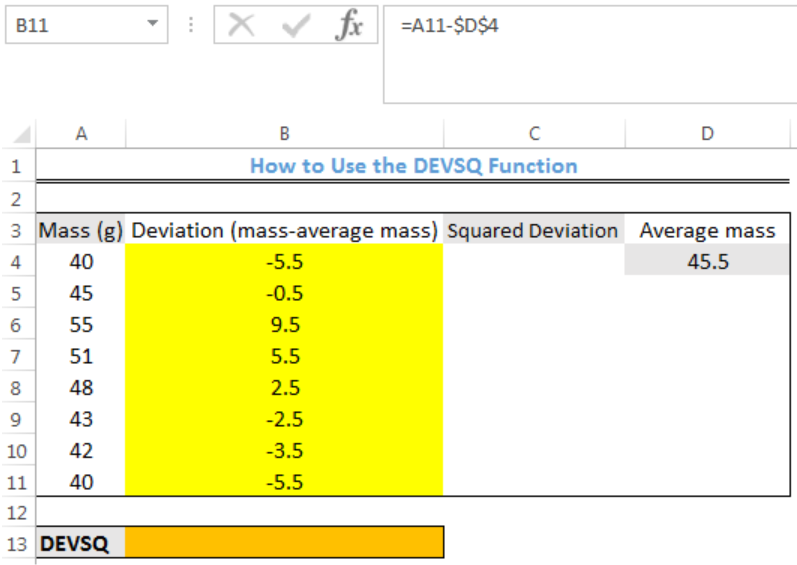We can use the DEVSQ function to calculate the sum of squares of deviations from the mean value of a data range. The steps below will walk through the process.
 Figure 1: How to Use the DEVSQ Function
Figure 1: How to Use the DEVSQ Function
Syntax
=DEVSQ([number1], [number2], [number2] ...)
Formula
=DEVSQ(A4:A11)
Setting up the Data
- We will set up the data by inputting the MASS into Column A
- We will put the deviation of the values in Column B
- Column C will contain the squared deviation of the values
- Column D contains the average mass
- Cell B13 is where our result with the DEVSQ function will be returned
 Figure 2: Setting up the Data
Figure 2: Setting up the Data
Using the DEVSQ function
- We will click on Cell B13
- We will insert the formula below into the cell
=DEVSQ(A4:A11) We will press the enter key
 Figure 3: Result with the DEVSQ Function
Figure 3: Result with the DEVSQ Function
Alternative Long Method
Calculating the Average Mass
- We will click on Cell D4
- We will insert the formula below into the cell
=AVERAGE(A4:A11) We will press the enter key
 Figure 4: Average Mass of the Data
Figure 4: Average Mass of the Data
Calculating the Deviation
- We will click on Cell B4
- We will insert the formula below into the cell
=A4-$D$4 We will press the enter key
 Figure 5: Deviation Value for Data in Cell A4
Figure 5: Deviation Value for Data in Cell A4
- We will click on Cell B4 again
- We will double-click on the fill handle (the small plus sign at the bottom right of Cell B4) and drag down to copy the formula into the other cells
 Figure 6: Deviation Values
Figure 6: Deviation Values
Calculating the Squared Deviation
- We will click on Cell C4
- We will insert the formula below into the cell
=B4^2 - We will press the enter key
 Figure 7: Squared Deviation Value for Data in Cell B4
Figure 7: Squared Deviation Value for Data in Cell B4
- We will click on Cell C4 again
- We will double-click on the fill handle (the small plus sign at the bottom right of Cell C4) and drag down to copy the formula into the other cells
 Figure 8: Squared Deviation Values
Figure 8: Squared Deviation Values
- We will sum the squared deviation by inserting the formula below into Cell C12
=SUM(C4:C11) We will press the enter key
 Figure 9: Sum of Squared Deviation Values
Figure 9: Sum of Squared Deviation Values
We can see that the result from the alternative method which is longer is the same with the first method.
Instant Connection to an Expert through our Excelchat Service
Most of the time, the problem you will need to solve will be more complex than a simple application of a formula or function. If you want to save hours of research and frustration, try our live Excelchat service! Our Excel Experts are available 24/7 to answer any Excel question you may have. We guarantee a connection within 30 seconds and a customized solution within 20 minutes.












Leave a Comment